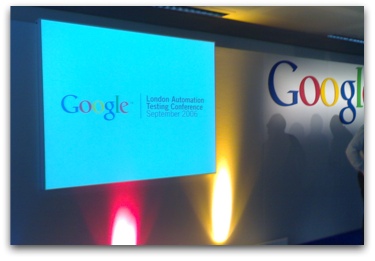
Google hosted a Test Automation Conference at their London offices on the 7th and 8th of September. The videos of the presentations are on Google Video, so rather than do a blow-by-blow account of each talk, I thought I’d note down what I saw as the main themes.
- Domain languages — and literate programming. I saw a number of
threads where quite rich languages were used to express unit tests,
either built-in to systems (like Fit) or via a library for Java. The
literate side means writing tests along the lines of
assertThat(thePage, has(selectBox().named("region"))), with the trick being of removing the dots and brackets to produce a test that a customer or a business analyst could understand. I have my doubts about the effort/reward of that, but I can see an advantage if you can attach that style of writing to a story or requirement. - Performance measurement — looks like there’s a lot to be gained from running nightly benchmarks against code commits, so developers can see when they’ve checked in something that hurts performance. That would be a heck of a lot more effective than my approach of reaching for the code profiler every now and then. But how do you know your benchmarks reflect the performance of deployed systems running on production hardware? You don’t, but if you’re the sort of organization that uses many cheap machines in preferences to a few large servers, you’re in a better position.
- Configuration and deployment — there’s some interesting work going on dealing with exploring large spaces of configuration options, and in testing against deployed systems. To take the latter first, some organizations strongly separate production machines from development machines, which makes testing web services (as an example) difficult because of firewall issues. That needs to change. Regarding configuration, there’s some smart work going on to automatically explore the space of configuration options using some random and some AI techniques. The study presented suggests that sampling the space of options is a pretty good approximation to exhaustive search, at least more so than you’d maybe guess.
- Mobile — the conference kicked off with Shannon Maher pointing out the difficulties of testing mobile applications (11,000 user agents x connectivity options x carriers … = combinatorial pain). The take-away point from that presentation was that this is an important problem to solve, with prizes for anyone who can solve it. Given that this was Google’s London director of mobile and director of engineering talking, I think it’s safe to assume that the prizes aren’t just toasters. But that was pretty much all that was said about mobile from an application developer perspective, which was surprising. Expect much more to be said in the future.
A few comments or thoughts that caught my attention: “any standard [W3C, OASIS, etc] without a test set doesn’t exist”; a round of applause for something described as being not XML; don’t write huge chunks of Javascript, instead separate your concerns as you would with other languages; “the interesting thing about objects is the messages between them, not their state”.
If you only have chance to watch a couple of videos, catch:
- Goranka Bjedov on Using Open Source Tools for Performance Testing. Aside from it being great content on performance testing, it gave me a sense of the kind of superstar bright people I hear Google employ.
- Jason Huggins on Selenium. I could have done with a more basic introduction to Selenium, but it’s interesting to see how the technology can be used to test a web UIs on multi-platforms in one go as part of CruiseControl. Ok, the demo didn’t work, but I have no doubts it would.
The slides and speaker bios are online too.
So, thanks to Google for arranging this, and to the host Allen Hutchison: it feels like the start of a community. The size was good (at 150 people) and there was enough time between presentations to actually talk to people and get to the bathroom and get some more coffee. Shame it clashed with d.Construct, but in all other respects it was a great success.

Links:
- Literate functional testing: Literate Testing framework, JMock 2.
- Performance: JMeter, Grinder.
- UI: Rhino, Selenium.
- Configuration and deployment: SmartFrog.org, GridUnit, Jester.
- Photos: Flickr “Google LTAC” search, Flickr group.